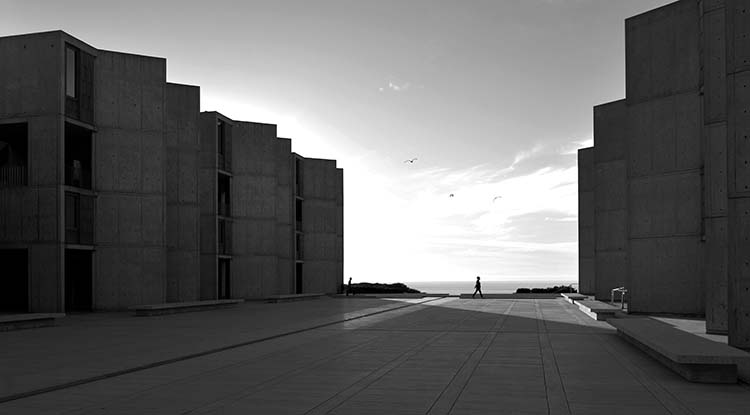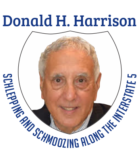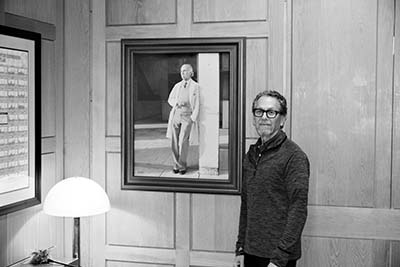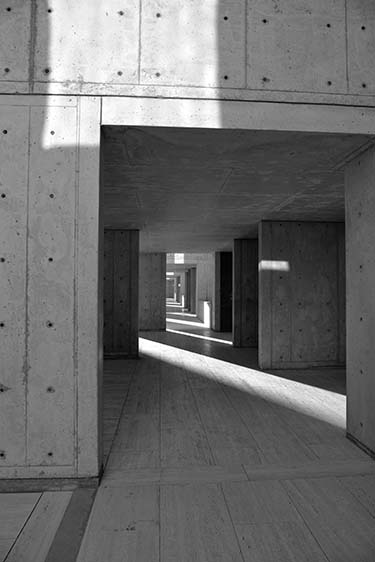 Editor’s Note: This is the 22nd chapter in Volume 2 of Editor Emeritus Donald H. Harrison’s 2022 trilogy, “Schlepping and Schmoozing Along the Interstate 5.” All three books as well as others written by Harrison may be purchased from Amazon.com.
Editor’s Note: This is the 22nd chapter in Volume 2 of Editor Emeritus Donald H. Harrison’s 2022 trilogy, “Schlepping and Schmoozing Along the Interstate 5.” All three books as well as others written by Harrison may be purchased from Amazon.com.
Schlepping and Schmoozing Along the Interstate 5, Exit 29 (Genesee Avenue): Salk Institute for Biological Studies.

 From northbound Interstate 5, take the Genesee Avenue exit and turn left, staying in the two left lanes to expedite a left turn onto North Torrey Pines Road. Follow North Torrey Pines Road to a right turn onto Torrey Pines Scenic Drive. Turn left at 10010 N. Torrey Pines Road.
From northbound Interstate 5, take the Genesee Avenue exit and turn left, staying in the two left lanes to expedite a left turn onto North Torrey Pines Road. Follow North Torrey Pines Road to a right turn onto Torrey Pines Scenic Drive. Turn left at 10010 N. Torrey Pines Road.
LA JOLLA, California — Dr. Ronald Evans, a molecular biologist at the Salk Institute for Biological Studies, is a pioneer researcher into how hormones can turn gene receptors on or off and thereby control a body’s physiology. In the not-too-distant future, as a result of his research, someone may be able to obtain the benefits of exercise simply by taking a pill.
Evans works in a laboratory bequeathed to him by his colleague and mentor, the late discoverer of the polio vaccine, Jonas Salk. In one research project, Evans and his team studied the impact of exercise on a body’s genetic makeup. They found that exercise will activate a cascade of genes that prompt the body to produce a chemical form of energy known at ATP (adenosine triphosphate).
Evans was able to create a synthetic hormone that activates the cascade in absence of exercise. It started with Lance the Mouse being fed a small-molecule pill a day, every day for a month, and not being allowed to exercise. AT the end of the month, with no training, Lance tripled his ability to run. “I think we now have the longest-running untrained mouse in the world,” Evans said. “We can now empower a mouse who has never trained, put him on a mouse treadmill, and have him run nonstop for over 10 hours. This is very long for a mouse, very long for a human. I call it ‘super physiology.’ In this context, the pill confers the benefits of fitness in the absence of training.”

“So, here comes the question,” Evans continued. “Should people who are not exercising take ‘the pill’ to fend ff health risks such as diabetes, hypertension, heart disease, and cancer Keep in mind that computers, iPads, iPhones, cable TV are pervasive and train us to be sedentary. Simply said, technology undermines human behavior, and the next generation is going to grow up with technology from childhood onward.”
He noted that “most people do not get the minimum 45 minutes a day of exercise that the government recommends. So, what if we take a pill on a daily basis? Is that good? There are a lot of ethical issues about what to do when you can begin to gain control over bodily systems.”
The question is not just academic. Research has advanced to a point that a Boston company is now conducting clinical trials with the ‘exercise pill’ in children with muscular dystrophy, Evans said.
Evans, a member of Congregation Beth Israel, said his Judaism attunes him to ethical values. He commented that an exercise pull could be used or misused. It would be unethical for someone competing in an athletic contest to take such a pill, as it would give that person an unfair advantage over those who have trained by exercising. On the other hand, such a pill may help people who are confined to bed or a wheelchair, or even those whose addiction to computers has resulted in an increasingly sedentary lifestyle.
Evans said an unforeseen result of computers and Internet games is that some children “don’t run around, and do not expend energy, and so there is an obesity epidemic through technology.” Furthermore, programs like Facebook “isolate people and they move much less, and that is not going to go away.” If this trend is unchecked, he said, it will be a “metabolic disaster.”
Even as exercise can be simulated through genetic manipulation, so too can the body’s genetic regulators for gaining or losing weight. Another pill Evans created makes the body “think” that it just had a meal. “It activates fat-burning pathways but since there are no calories coming in, you actually windup burning energy and losing weight,” he said.

“The body ‘thinks’ that you are overly full, so it shuts down your appetite,” he explained. “It uses energy to try to grab the calories that aren’t there,” the molecular biologist said.
Synthetic hormones also can be used “to address diseases like cancer, diabetes and diseases of the central nervous system,” he said. In response to his brother Stewart’s death from acute promyelocytic leukemia, Evans developed a synthetic retinoid used as a novel treatment. “Now a leukemia that once was universally lethal is now universally cured.”
There is something reassuring about Evans doing trailblazing research on possible cures for major diseases in the quarters once used by Jonas Salk, who built the Institute after discovering the vaccine for polio. Evans said he knew Salk very well; “I was one of the closer faculty to Jonas when my lab was expanding.” About 30 years ago, Salk was shutting down his research program and “he invited me to take over his lab. It was the premier lab. We had it remodeled into a beautiful space which I am still in,” Evans related.
“He had the best office and the family wanted it to be maintained after Jonas’ passing,” Evans said. “It was not like I took the Louis Pasteur office. It didn’t have microscopes. The reason I got the office was because the family had say over what would happen to it.”
The office was located “next to something called the Fellows Room, which is a really beautiful meeting room,” Evans said. “Jonas did not want to be in the president’s office; he did not like being president. It was actually stressful to him. He also did not like raising money which was more stressful. He said, ‘It is painful for me when someone says no. It is just not for me to do.’ He was very shy, very soft spoken.”
Evans reminisced that he and Salk liked to walk around the Salk Institute’s grounds. “He liked to do a Darwin-type garden walk, to just think and casually interact with people. So, I got to know him fairly well. We had relatively long walks together. He would say, ‘Ron, you’re a mutant.’ I had no idea what he was talking about. I said, ‘I guess everyone is a mutant; no one is the same.’ He said, ‘No, that is not what I mean. If you are going to be creative, you have to be different. Mutans are the ones who change the rules. They change the planet. And that is who we want to hire.’ It was a very strange conversation. To Jonas, being creative has to be inherent; it is in your make up, one way or the other. He said, ‘That’s what we want because you are unencumbered by how others think.’”
Salk’s vision, Evans said, was to surround himself “with other pioneers and visionaries in many fields – mathematics, physics, medicine, all aspects of biology, and neuroscience. The Institute wasn’t built for a specific goal; it was built to incubate ideas. He built it with the best people…
“It’s hard to climb from low to high,” Evans continued. “You almost have to start at a peak of high. You get the best people from around the world. He created a culture that remains until today. Salk is one of the more impactful research centers, with a relatively small faculty but a big impact.”
Evans related that nuclear physicist Leo Szilard, one of the creators of the atomic bomb and the author of the letter that Albert Einstein penned about the Manhattan Project, originated the idea of the Salk Institute in the late 1950’s. “He went to Jonas and said, ‘Your famous because you came up with the polio vaccine and now you can do something special and the time to do it is now.’ He even said to build it in La Jolla because he liked it in La Jolla.”
In 1995, Salk was ailing and Nobel laureate Francis Crick, the discoverer of DNA, was serving as the Institute’s temporary president. Salk made a request of Evans, saying: “There is this event in Hawaii that the March of Dimes is honoring me. I don’t feel good enough to travel, so I want you to go.’ I said, ‘I can’t replace you,’” however Salk was insistent.
“So my family and I went to Hawaii, and we get into the presidential suite on the Big Island. It was crazy, a gigantic entry way, you could have a massive party in there, and an embroidered cane welcoming Dr. Salk. It was beautiful. The ceremony was set for the following evening. So, the next morning we went to the beach, not knowing the Salk Institute was trying to reach me (we didn’t have cell phones at the time) to tell me that Jonas just passed away the very day of the event for him to be feted.
“In giving the presentation that day, I reflected that science, philosophy, art are intensely human enterprises driven as much by the heart as by the head. When I look at my resume, I see the colleagues and friends from around the world and a cauldron of ideas and rich emotion.”
“It turned into a very different-type occasion,” Evans said. “It remains one of the memories to be treasured over the years.”
*
Donald H. Harrison is editor emeritus of San Diego Jewish World. He may be contacted via donald.harrison@sdjewishworld.com